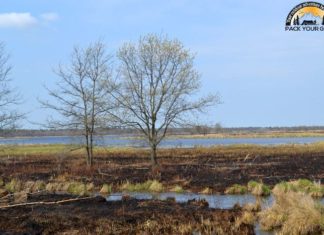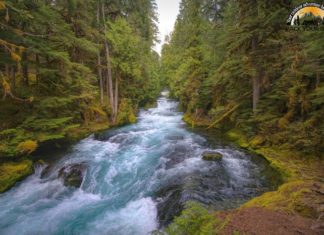
On May 29, 1838, Wisconsin was admitted to the union as the 30th state of the United States. Wisconsin is surrounded by part of Lake Superior and the Upper Peninsula of Michigan and Lake Michigan. The neighboring states are Illinois on the south, Minnesota on the west, and Iowa on the southwest.
The word Wisconsin was originated from the French meaning “this stream of red stone“, denoting the Wisconsin river. Madison is the capital of Wisconsin.
In the state of Wisconsin, there are several national parks, and camping grounds as its geography is diverse. Let’s explore all the important Wisconsin National Parks on this page.
Apostle Islands National Lakeshore
The Apostle Islands National Lakeshore is Wisconsin's national park consisting of 21 islands known as Apostle Islands. Explore this Wisconsin national park here.
Chequamegon Nicolet National Forest
The Chequamegon Nicolet National Forests are located in Wisconsin's Northwoods. The name Chequamegon derives from the Chippewa Indian language and means "place of shallow water."
Gravel Island National Wildlife Refuge
Gravel (4 acres) and Spider (23 acres) islands comprise the Gravel Island National Wildlife Refuge. These islands are located in Lake Michigan, east of the Door county peninsula.
Green Bay National Wildlife Refuge
The island was set aside by Executive Order in 1913 as a preserve and breeding ground for native birds. Along with Gravel Island National Wildlife Refuge, Green Bay National Wildlife Refuge makes up the Wisconsin Islands Wilderness Area.
Horicon National Wildlife Refuge
Over 21,000 acres in size, Horicon National Wildlife Refuge is located on the west branch of the Rock River in southeastern Wisconsin and encompasses the northern two-thirds of Horicon Marsh.
Ice Age National Scenic Trail
The Ice Age National Scenic Trail travels through the edges of the glacier that passed into Wisconsin.
Iron River National Fish Hatchery Complex
Iron River National Fish Hatchery (NFH) Complex was established in 1981. This hatchery is located in the upper Great Lakes region and is stocked with fish and eggs.
Leopold Wetland Management District
The Leopold Wetland Management District is named after Aldo Leopold, who is widely acknowledged as the father of wildlife conservation in America.
Necedah National Wildlife Refuge
Whooping cranes, wolves, Karner blue butterflies, and white-tailed deer call Necedah National Wildlife Refuge "home." Ringed bog hunter dragonflies live in sedge meadows, flying squirrels in upland hardwood timber.
North Country National Scenic Trail
The North Country National Scenic Trail links scenic, natural, historic, and cultural areas in seven northern states. The approximately four thousand mile long trail incudes a variety of hikes from easy walking to challenging treks.
Saint Croix National Scenic River
Calm or dancing waters surrounded by shades of green, the Saint Croix National Scenic Riverway provides 252 miles of recreational opportunities. Explore this scenic river on this page.
Trempealeau National Wildlife Refuge
Trempealeau National Wildlife Refuge is 6,200-acre refuge lies within the Mississippi flyway, along the Mississippi River in western Wisconsin. Explore this Wisconsin's NWR here.
Whittlesey Creek National Wildlife Refuge
Whittlesey Creek National Wildlife Refuge is part of a large wetland complex on Lake Superior, near Ashland, Wisconsin. These coastal wetlands are a significant part of the wildlife habitat and aquatic resources of the south shore of Lake Superior.
















![How To Pick The Best Camper Levelers? [An Ultimate Buyer’s Guide] Best Camper Levelers](https://packyourgear.com/images/Best-Camper-Levelers-100x70.jpg)





